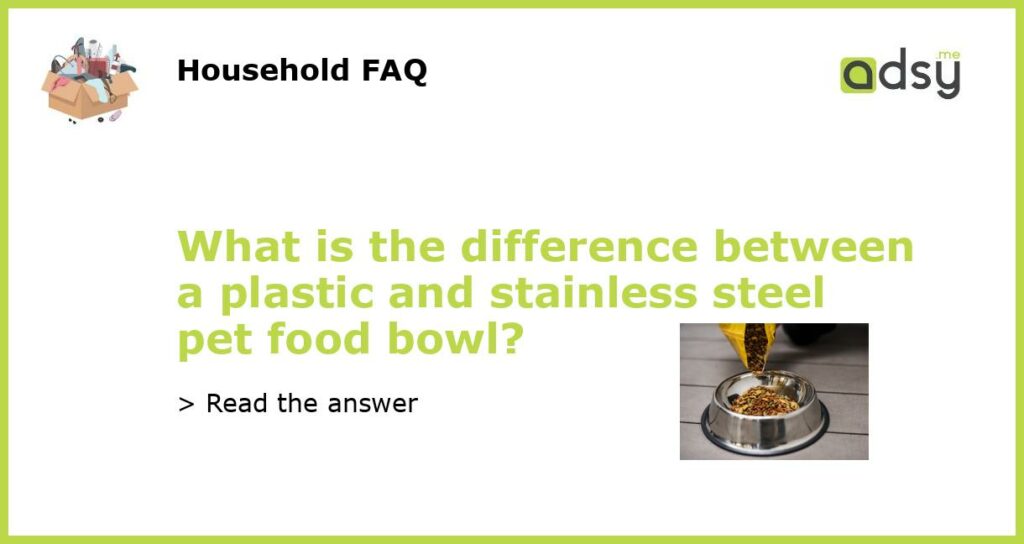Plastic vs Stainless Steel Pet Food Bowls: What’s the Difference?
When it comes to feeding our furry friends, choosing the right food bowl is an important decision. Plastic and stainless steel are two popular materials for pet food bowls, each with its own set of advantages and disadvantages. Understanding the difference between the two can help you make an informed choice for your pet’s feeding needs.
The Pros and Cons of Plastic Pet Food Bowls
Plastic pet food bowls are a common choice due to their affordability and wide range of available designs. However, there are some important factors to consider before opting for a plastic bowl.
- Affordability: Plastic bowls are generally more affordable compared to stainless steel. If you are on a budget, plastic might be the right choice for you.
- Design and Variety: Plastic bowls come in a wide range of sizes, colors, and patterns, allowing you to find one that matches your pet’s personality or fits your home decor.
- Lightweight: Plastic bowls are lightweight, making them easy to move around or take on the go. This can be particularly convenient for travel or outdoor activities.
- Potential for Bacteria: One of the downsides of plastic bowls is that they are more prone to scratches, which can harbor bacteria and lead to odor or health issues. Regular cleaning is essential to maintain their hygiene.
- Wear and Tear: Over time, plastic bowls may develop cracks or scratches that can harbor bacteria or cause the bowl to break, potentially posing a health risk to your pet.
The Advantages and Disadvantages of Stainless Steel Pet Food Bowls
Stainless steel pet food bowls are another popular option, known for their durability and easy maintenance. Here are some key points to consider when choosing a stainless steel bowl.
- Durability: Stainless steel bowls are more durable than plastic bowls, as they are resistant to cracks, scratches, and stains. They can withstand rough handling and are less likely to break.
- Hygiene: Stainless steel bowls are non-porous, making them resistant to bacteria and easy to clean. They can be safely washed in the dishwasher or by hand.
- Longevity: Due to their durability, stainless steel bowls generally have a longer lifespan compared to plastic bowls. This can save you money in the long run, as you won’t need to replace them as frequently.
- Heat and Cold Resistance: Stainless steel bowls can withstand extreme temperatures without warping or cracking, making them suitable for both hot and cold foods.
- Colder to the Touch: Some pets may prefer the cooler feel of stainless steel bowls, especially during hot weather. However, this can be a disadvantage during colder seasons.
Making the Right Choice for Your Pet
Choosing between plastic and stainless steel pet food bowls ultimately depends on your pet’s needs and your personal preferences. Here are some factors to consider when making your decision:
- Size and Breed: Consider the size and breed of your pet. Larger dogs may require a heavier and more durable bowl, while smaller dogs or cats may benefit from the lightweight nature of a plastic bowl.
- Feeding Habits: If your pet is a vigorous eater or tends to push their bowl around, a stainless steel bowl may be the better choice, as it is less likely to tip over or slide across the floor.
- Allergies and Sensitivities: Some pets may have allergies or sensitivities to certain materials. If your pet has shown any adverse reactions in the past, it may be safer to opt for a stainless steel bowl.
- Maintenance: Consider your willingness and availability to clean and maintain the food bowl. Stainless steel bowls are generally easier to clean and maintain over time.
- Budget: If you are on a tight budget, a plastic bowl may be a more affordable option.
The Bottom Line
Choosing between a plastic and stainless steel pet food bowl is a decision that should take into account your pet’s needs, your budget, and your personal preferences. Both materials have their own advantages and disadvantages, so consider these factors before making your final choice. Remember, the most important thing is to provide your pet with a clean, safe, and comfortable feeding experience.






